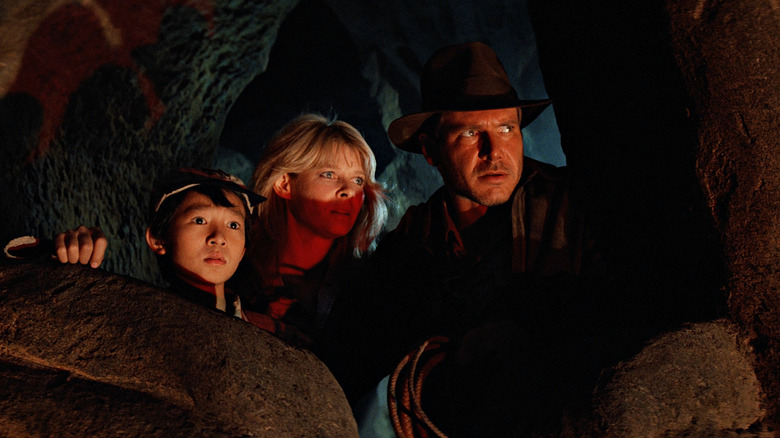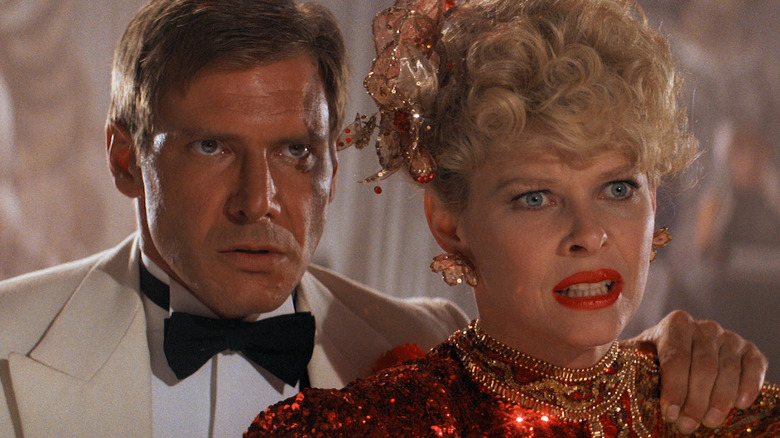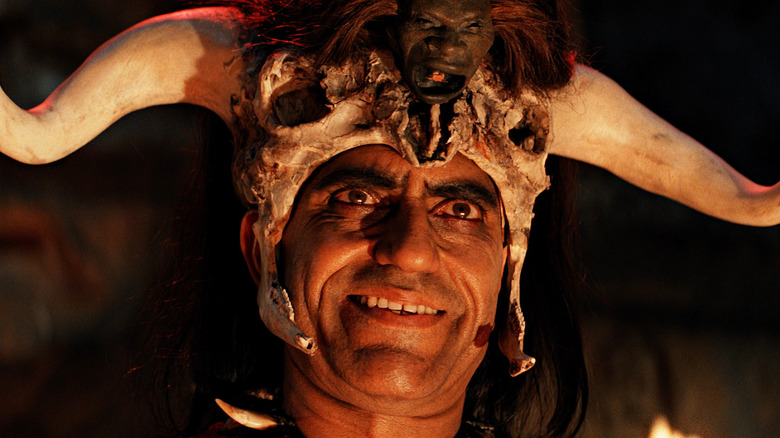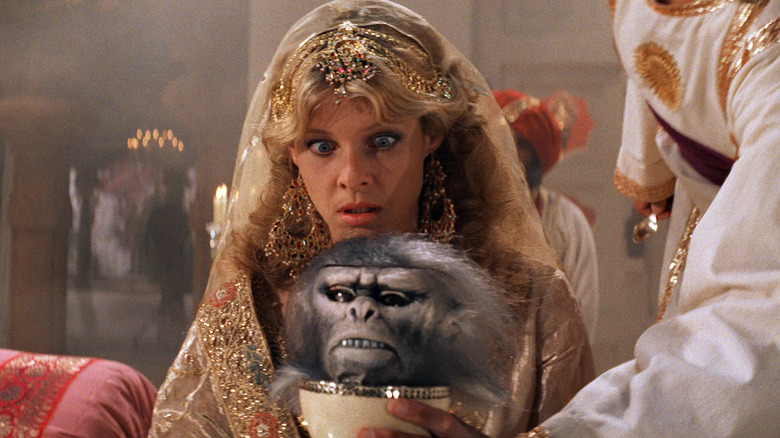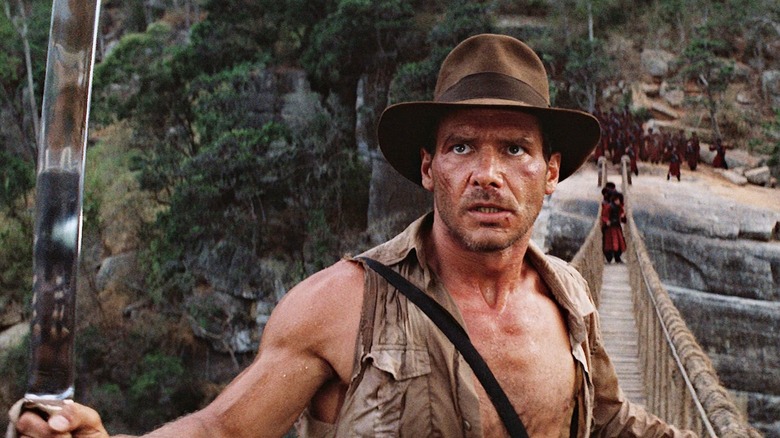Directing Indiana Jones And The Temple Of Doom Was A Tough Decision For Steven Spielberg
If the Indiana Jones movies had been made in chronological order, the Thuggee cult in "Indiana Jones and the Temple of Doom" might have made pretty good bad guys for our intrepid adventurer to warm up on before tackling the greater peril of the Third Reich. After all, the real-life Thugs were proper nasty bastards, posing as travelers to waylay and murder around 30,000 people in early 19th century India, strangling their victims and offering them as a sacrifice to Kali, not to mention nicking all their stuff.
"Temple of Doom" screenwriters Willard Huyck and Gloria Katz made them even worse, adding voodoo magic, enslaving children, turning people into zombies, and ripping out people's hearts to the Thuggee repertoire. And yet it still wasn't quite enough, because "Raiders of the Lost Ark" came first, and "Raiders" had the Nazis, those go-to cinematic (and real world) villains. After a whole movie beating up and melting Nazis, the poor old Thugs were always going to feel very small beer.
That villain problem at the center of "Temple of Doom" pretty much sums up the whole movie. It tries to go darker, but feels more inconsequential; tries to pump up the action and the spectacle, but feels smaller in scale; tries to be scarier, but undermines the horror with its inherent silliness. George Lucas wanted to emulate "The Empire Strikes Back" with a darker second adventure for Indiana Jones, but that was a tricky act to follow. As a result, "Temple of Doom" became the largely unloved middle child of the original Indiana Jones trilogy, regarded as something of a misfire from Spielberg while he was on a hot streak with "Raiders" and "E.T." But then, the director wasn't totally committed to the project in the first place.
So what happen in The Temple of Doom again?
A year before the events of "Raiders of the Lost Ark," we meet adventurer Indiana Jones (Harrison Ford) in a Shanghai nightspot where a deal with Lao Che, a Chinese gangster, is about to go chaotically south. Poisoned and outgunned by Lao's goons, Indy makes his escape, taking showgirl Willie Scott (Kate Capshaw) with him. Picked up by his young sidekick Short Round (Ke Huy Quan, recently on a career comeback), they head to the airport and jump on the next flight out. Unfortunately for them, the plane belongs to the gangster.
Lao's pilots wait until their three passengers are asleep before dumping the aircraft's fuel and bailing out. Our heroes awake in time to fashion another unlikely escape using an inflatable life raft, which turns out perfect for sledding in the Himalayas. Falling off a cliff and landing safely in a river, they are carried to a small village in India.
A terrible plight has befallen the community. Not only have evil inhabitants of a nearby palace stolen their sacred Sankara stone, but all the children have also gone missing, too. Indy agrees to recover the artifact for the villagers and the trio head to the opulent Pankot Palace, where they receive a cordial welcome. Treated to a lavish but very gross banquet, Indy's inquiries about the Stone and the Thuggee cult are dismissed as the stuff of legend, but his suspicions are confirmed when an assassin attacks him in his room.
Indy locates a secret tunnel leading to a Thuggee temple deep beneath the palace, where the high priest Mola Ram (Amrish Puri) is making a human sacrifice to Kali. Behind the scenes, the enslaved local kids are digging for the last two Sankara stones, which Ram believes will grant the cult all-conquering power.
The darkest and most problematic Indy adventure
Hollywood movies weren't always the most culturally sensitive back in the '80s. Just take the Asian stereotyping in "Sixteen Candles" or Fisher Stevens going brownface in "Short Circuit." But "Temple of Doom" caused controversy from day one thanks to its insensitive depiction of Indian culture, accusations of Orientalism, and casting Indiana Jones as a white savior figure.
The violence also caused some concern. Along with "Gremlins," "Temple of Doom" was responsible for the creation of the PG-13 rating by the MPAA (Motion Picture Association of America). Blow for blow and scare for scare, there isn't a huge amount of difference between "Raiders" and its prequel, but the difference lies in the tone and lighting. Even in its underground sequences, "Raiders" is well lit to facilitate the adventure element, while "Temple" has a far more ghoulish ambiance to accentuate the horror.
A good example of the difference in tone is two scares involving decomposing corpses. In the opening scene of "Raiders," Indy spots a spike trap and sets it off, causing a cadaver to spring from the wall. Aside from being a decent jump, it also shows us how savvy he is in these situations, and the fright is balanced by the humor of Alfred Molina's terrified reaction. In "Temple of Doom," Short Round needlessly tugs a door handle, releasing two corpses in chains. It's like something that pops out on a ghost train ride and only really serves to set up another round of screaming for Willie.
All in all, "Temple of Doom" is a cracking adventure that is far darker and weirder than its predecessor. For its faults, I prefer its nastier edge to the goofball buddy comedy in "The Last Crusade," although it's definitely the only Indiana Jones movie I won't let my kids watch.
Both producer and director were in a dark place
While the intention was always to make a darker second adventure to mirror "The Empire Strikes Back," George Lucas acknowledged that his and Spielberg's personal circumstances led them to take it even further in that direction (via Empire):
"Part of it was I was going through a divorce, Steven had just broken up and we were not in a good mood, so we decided on something a little more edgy. It ended up darker than we thought it would be. Once we got out of our bad moods, which went on for a year or two, we kind of looked at it and went, 'Mmmmm, we certainly took it to the extreme.' But that's kind of what we wanted to do, for better or worse."
Bearing this in mind, it's tempting to surmise that they used "Temple of Doom" to get a little payback on women. While Marion in "Raiders" was every bit the equal of Indiana Jones, Willie Scott is a complete caricature. It's like two disgruntled blokes sat in a bar griping about all the things that annoyed them about women and lumped them all together in one character.
A lot of stuff happens at her expense, and we're invited to laugh at her as she freaks out about jungle creatures around the campfire and her horrified reactions at the banquet. When she finds herself swarmed by bugs, it's almost presented as a comeuppance for being so vain and preening about her appearance. Thanks to the punishment Lucas and Spielberg put her through, Willie spends most of the movie shrieking. It's not a great character trait, and she's easily one of the most irritating characters in whole franchise.
Did Spielberg even want to direct the film?
Spielberg's reaction to "Temple of Doom" flip-flopped quite significantly. After the film was first released, he seemed to think it equal or even superior to "Raiders" (via From Director Steven Spielberg):
"Having seen both movies now, I can truthfully say that 'Temple of Doom' is another kind of adventure movie. There's more of a careful balance... between horror and comedy than there was in 'Raiders of the Lost Ark,' which was a straight-arrow adventure, at times even a conservative adventure."
He later backtracked on that opinion, saying:
"I wasn't happy with 'Temple of Doom' at all. It was too dark, too subterranean, and much too horrific. I thought it out-poltered 'Poltergeist.' There's not an ounce of my personal feeling in 'Temple of Doom.'"
The director's change of tune may come down to the fact that he wasn't completely sold on directing the film in the first place. He had just come from directing back-to-back Best Picture Oscar nominees ("Raiders" and "E.T.") and was working on a semi-autobiographical musical called "Reel to Reel," which he eventually shelved in 1983 to take on "Temple of Doom:"
"I knew if I didn't direct, somebody else would. I got a little bit jealous, I got a little bit frustrated and I signed on for one more."
Jealousy and frustration don't sound like the best motivation to make a movie, but at least the final product wasn't just a retread of the much-loved first film. And, if you look at some of the Indiana Jones ripoffs lurking around at the time like "King Solomon's Mines," even half-hearted Spielberg is better than most.
